When choosing perennials to grow in containers, it is important to imagine how they will appear as they develop and reach maturity.
Are there certain textures you prefer? Do you want just one plant per container, or would you prefer several different plants that have complimentary or contrasting colors?
One trick is to plant a low-growing or trailing plant with a medium-height plant and a tall plant to create visual interest.
As far as colors go – that’s totally up to you – just know that this is often the most fun part of planning, so take your time when deciding.
As long as you provide adequate growing conditions, your potted perennials should not give you many problems.
The following are the top 25 perennials you can grow in containers. You can mix and match perennials to suit your needs and select the ones that work best for you.
1. Aster
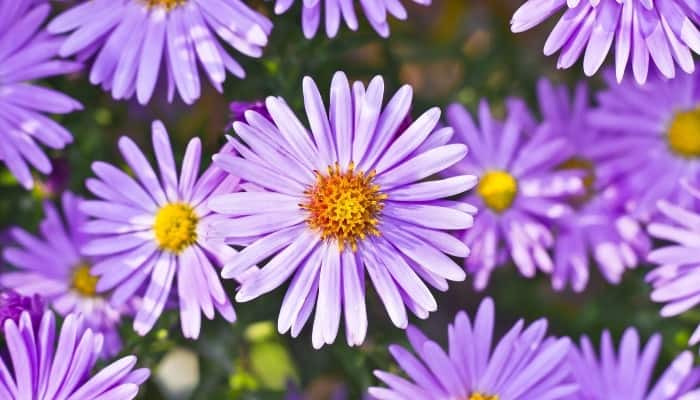
Asters come in many colors and their cheerful blooms brighten up any room you put them in.
These perennials have another advantage – they bloom late in the summer and early fall long after other flower plants have faded.
- Botanical Name: Symphyotrichum
- Best for Grow Zones: 3-8 USDA
- Average Size: 1-6 feet tall, 1-4 feet wide
- Colors Available: Pink, purple, white, blue
- Light Requirements: Full sun
- Popular Varieties: Celeste, Hazy, Puff
2. Coral Bells
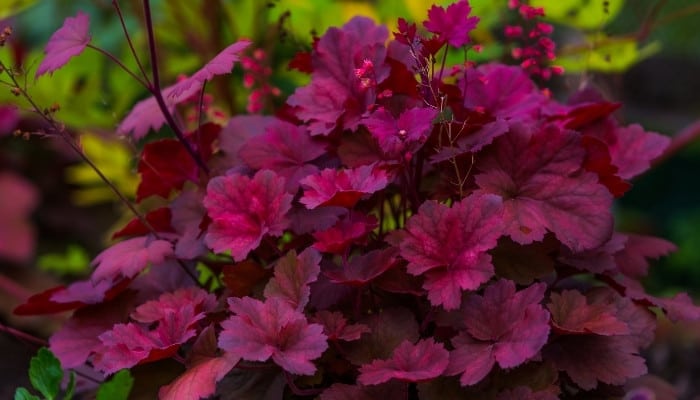
If you like your potted plant to get into shape with little interference from you, then coral bells are a good choice.
The plant has a mounding growth habit and features bell-shaped flowers that are an ornamental asset in any setting.
- Botanical Name: Heuchera
- Best for Grow Zones: 4-8 USDA
- Average Size: 8-18 inches tall, 12-24 inches wide
- Colors Available: Orange, pink, coral, red, white
- Light Requirements: Full sun to partial shade
- Popular Varieties: Autumn Leaves, Chocolate Ruffles, Green Spice, Marmalade
3. Dianthus
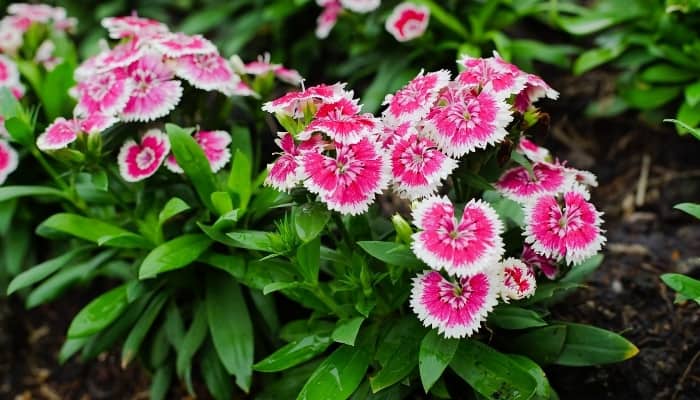
Whether in bloom or not, Dianthus is an attractive plant with a lot going for it. The gray-blue foliage fits well as a backdrop to other late blooming plants.
As for the flowers, they come in different colors. Choose a variety that suits you since some varieties have trailing habits while others grow upright.
- Botanical Name: Dianthus spp.
- Best for Grow Zones: 3-9 USDA
- Average Size: 6-36 inches tall, 6-24 inches wide
- Colors Available: Pink, white, lilac, red, pink
- Light Requirements: Full sun
- Popular Varieties: Arctic Fire, Firewitch, First Love, Rose de Mai
4. Lady’s Mantle

Turn your backyard into an English garden with cottage-style charm with the lady’s mantle. It has a slow growth rate which means less maintenance and pruning.
However, it’s considered an invasive plant in some states, so check the local rules before planting it.
- Botanical Name: Alchemilla mollis
- Best for Grow Zones: 3-8 USDA
- Average Size: 12-18 inches tall and wide
- Colors Available: Yellow-green
- Light Requirements: Full sun to partial shade
- Popular Varieties: Thriller, Auslese, Irish Silk, Robusta
5. Daisies
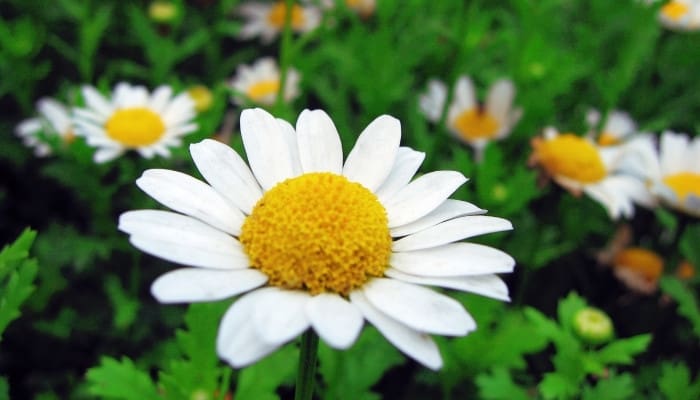
When it comes to daisies, people have mixed feelings. For some, the daisy flower bed is the focal point in the garden. For others, it’s nothing more than weed.
However, when in bloom, it attracts pollinators of different types and the flowers lend a cheery atmosphere to the surroundings.
- Botanical Name: Bellis perennis
- Best for Grow Zones: 4-8 USDA
- Average Size: 6-12 inches tall and wide
- Colors Available: White, pink, red
- Light Requirements: Full sun to partial shade
- Popular Varieties: Shasta, Gerbera, Galaxy Red, Pomponette, Tasso Strawberries and Cream, Habanera Mix
6. Tickseed
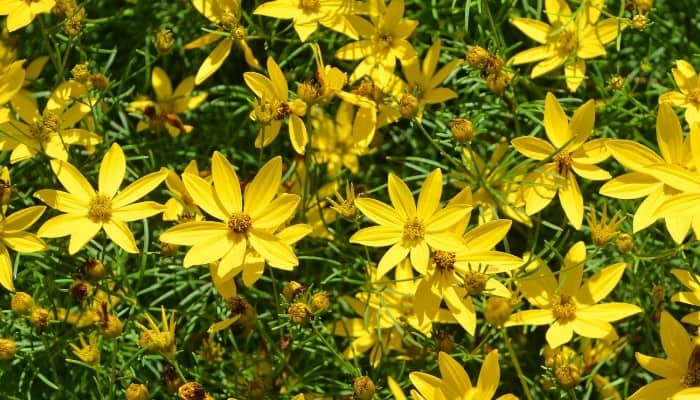
If you don’t like daisies, you can try tickseeds. These cultivars belong to the aster family and have a reasonable growth rate.
They require little maintenance and have a long bloom season that starts in late summer and continues into the early fall.
- Botanical Name: Coreopsis verticillata
- Best for Grow Zones: 3-9 USDA
- Average Size: 1.5 to 2 feet tall and wide
- Colors Available: Yellow
- Light Requirements: Full sun
- Popular Varieties: Golden tickseed, Coreopsis grandiflora, Coreopsis rosea
7. Ferns
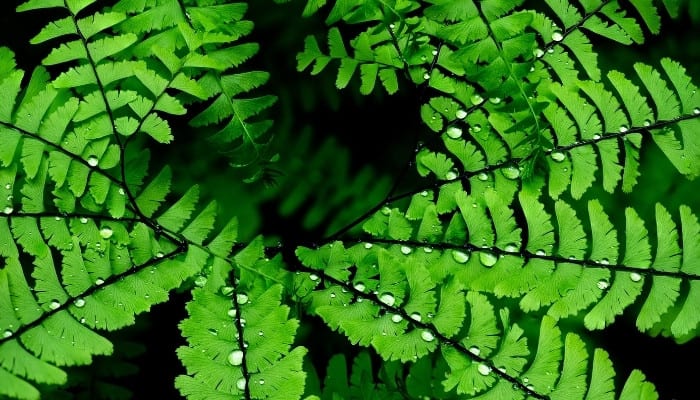
Ferns are the mainstay of any tropical garden, and since there are plenty of species to choose from, the only limit is your imagination.
The only drawback is they need hot and humid climates to grow. So, if you live in zones below 9, a greenhouse is your best option.
- Botanical Name: Varies based on type
- Best for Grow Zones: 9-11 USDA
- Average Size: 2 to 3 feet tall and wide
- Colors Available: Green, silver, burgundy, gold, blush
- Light Requirements: Partial shade
- Popular Varieties: Foxtail fern, Japanese painted ferns, Dixie wood ferns
8. Torch Lily
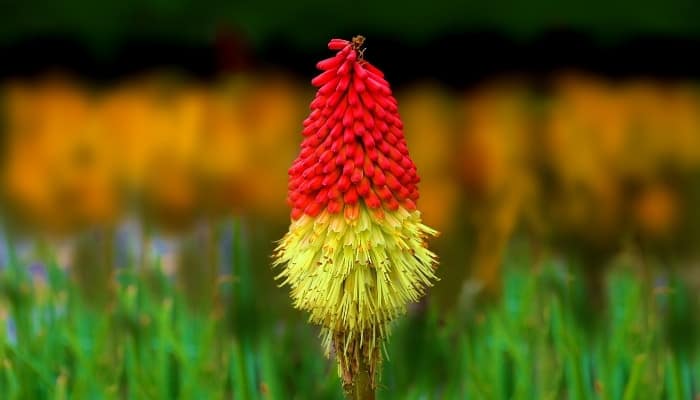
Torch lilies have little to do with lilies since they’re not members of the Liliaceae family, but all is forgiven when summer comes and the flowers open.
The bright fiery colors transform the garden overnight. The bloom season lasts all summer.
- Botanical Name: Kniphofia
- Best for Grow Zones: 6-9 USDA
- Average Size: 2-4 feet tall, 1-3 feet wide
- Colors Available: Red, yellow, orange
- Light Requirements: Full sun
- Popular Varieties: Red Hot Popsicle, Pineapple Popsicle, Mango Popsicle, Ice Queen
9. Yarrow
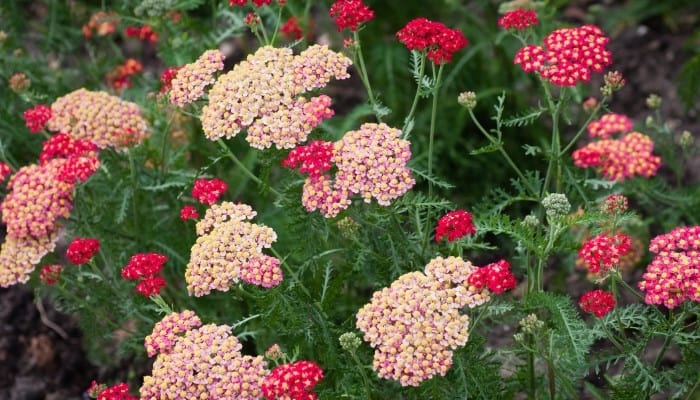
Yarrow plants are a staple of many gardens. The leaves are similar to ferns, and the flowers grow on top of long stalks in different bright colors.
Plant it in the fall, and wait for the blooms the next spring. It can be invasive, so growing in containers is wise.
- Botanical Name: Achillea millefolium
- Best for Grow Zones: 3-9 USDA
- Average Size: 2-3 feet tall and wide
- Colors Available: White, yellow, pink, red
- Light Requirements: Full sun
- Popular Varieties: Apple Blossom, Cerise Queen, Little Moonshine, New Vintage Red, Paprika
10. Bergenia
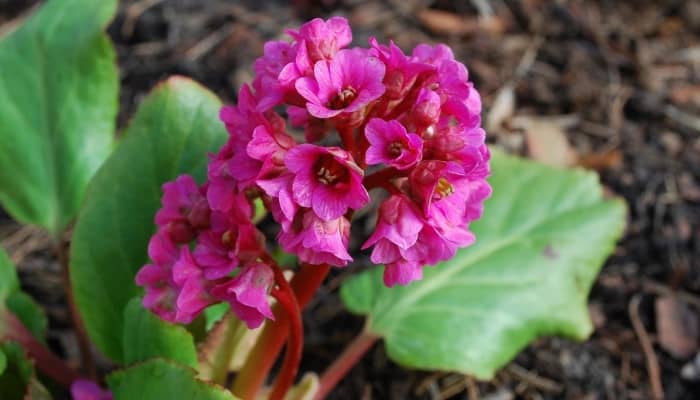
When the leaves of this perennial rub together they make a sound similar to a pig’s. This is why it’s known as pig squeak, but the dainty flowers make up for it.
Plant it in moist, rich soil, and enjoy a splash of color every April.
- Botanical Name: Bergenia cordifolia
- Best for Grow Zones: 4-8 USDA
- Average Size: 1-2 feet tall and wide
- Colors Available: Pink, red, white
- Light Requirements: Partial to full shade
- Popular Varieties: Winter Glow, Bressingham White, Angel Kiss, Ballawley, Solar Flare
11. Forget-Me-Nots

Between the pink buds and blue blooms, what’s there not to like about the forget-me-nots?
They take up to a year to mature and start blooming, so plant them in the summer, and look forward to future cheerful blooms.
- Botanical Name: Myosotis
- Best for Grow Zones: 3-8 USDA
- Average Size: 1 foot tall and wide
- Colors Available: Pink, white, yellow, blue
- Light Requirements: Full to partial sun
- Popular Varieties: Myosotis stricta, Myosotis latifolia, Myosotis sylvatica, Blue Basket, Music, Pompadour
12. Bellflower

Known for its hardiness and disease resistance, the bellflower is the kind of perennial that grows just about anywhere.
It’s not finicky about the soil, growing conditions, or lack of nutrients in the soil. It’s the type of perennial to plant in a container and forget about it.
- Botanical Name: Campanula persicifolia
- Best for Grow Zones: 3-7 USDA
- Average Size: 24 inches tall
- Colors Available: Lilac, blue, white
- Light Requirements: Full sun to partial shade
- Popular Varieties: Fleur de Neige, Kelly’s Gold, Telham Beauty
13. Creeping Phlox
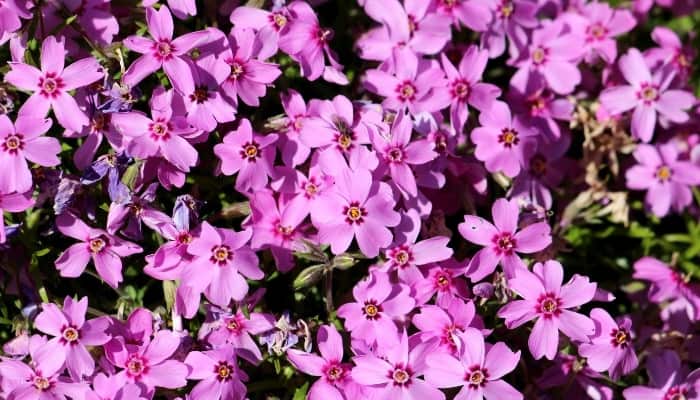
These plants are ideal as ground covers, but they do well in containers too, especially when paired with a tall focal-point plant.
They form a dense mat of lush green colors. However, you need to prune them regularly during the growing season to keep them in shape.
- Botanical Name: Phlox stolonifera
- Best for Grow Zones: 5-9 USDA
- Average Size: 6-12 inches tall and 3-9 inches wide
- Colors Available: White, pink, purple
- Light Requirements: Full sun to partial shade
- Popular Varieties: Fran’s Purple, Home Fires, Pink Ridge, Sherwood Purple
14. Larkspur
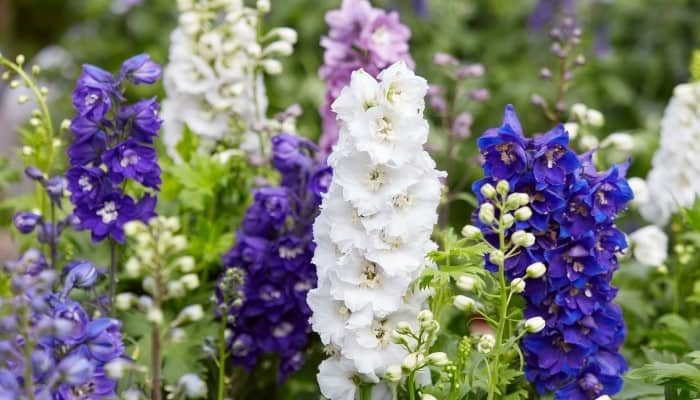
The deep and rich blue colors of the larkspur give this showy plant its rightful place at the center of any flower container garden.
Just make sure it has enough space to grow, and be wary of weeds as it doesn’t like competition.
- Botanical Name: Delphinium
- Best for Grow Zones: 3-7 USDA
- Average Size: 4-6 feet tall and 1 foot wide
- Colors Available: Pink, purple, white, red, blue
- Light Requirements: Full sun
- Popular Varieties: Black Knight
15. Daylilies
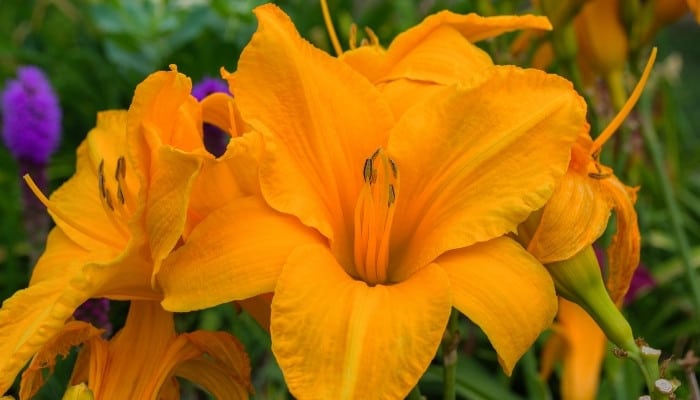
These hardy perennials have a high tolerance for drought and flooding. Their colorful blooms are just the icing on the cake.
Pair them with blue or purple flowers for an eye-catching summer display.
- Botanical Name: Hemerocallis spp.
- Best for Grow Zones: 3-10 USDA
- Average Size: 8 inches to 5 feet tall
- Colors Available: Red, orange, yellow, purple, pink
- Light Requirements: Full sun to partial shade
- Popular Varieties: Stella D’Oro, Purple D’Oro, Crimson Pirate
16. Periwinkle
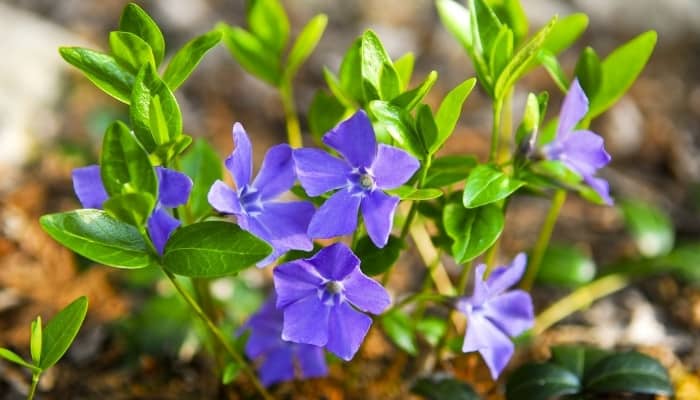
Although the violet flowers of periwinkle are small and easy to miss, they stay in bloom from the spring well into the fall.
The short plant is an ideal low-growing choice for containers. It doesn’t require a lot of maintenance and is easy to grow.
- Botanical Name: Vinca minor
- Best for Grow Zones: 4-8 USDA
- Average Size: 18 inches long
- Colors Available: Purple, blue, lavender, white
- Light Requirements: Full sun to partial shade
- Popular Varieties: Vinca major, Vinca minor
17. Dwarf Gardenia
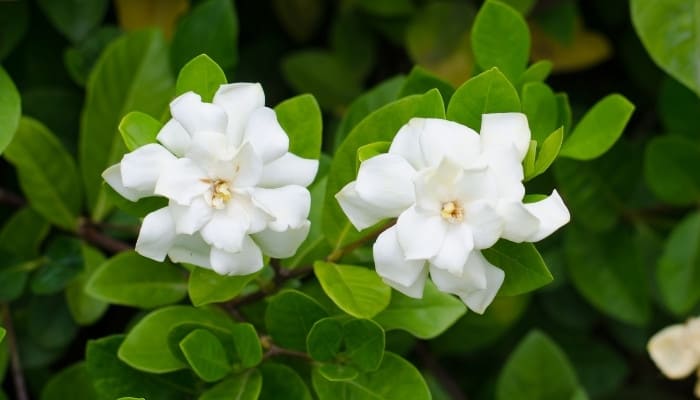
Gardenias seem to have it all. They have beautiful and fragrant blooms, and they grow well indoors. Due to their manageable size, they’re easy to grow in a medium container.
- Botanical Name: Gardenia jasminoides
- Best for Grow Zones: 8-11 USDA
- Average Size: 6-12 inches tall and 1-2 feet wide
- Colors Available: Cream and white
- Light Requirements: Partial shade
- Popular Varieties: Buttons, Crown Jewel, Kleim’s Hardy
18. Purple Coneflowers
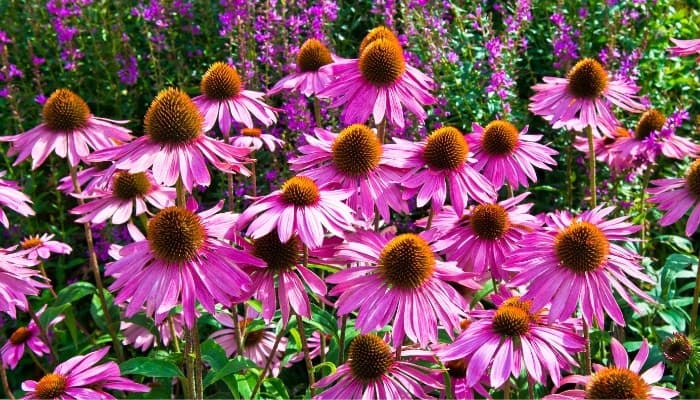
A staple of the prairies in eastern North America, these are hardy perennials that don’t need a lot of attention or special conditions to grow.
- Botanical Name: Echinacea purpurea
- Best for Grow Zones: 3-8 USDA
- Average Size: 2-3 feet tall and 1-2 feet wide
- Colors Available: Purple and pink
- Light Requirements: Full sun to partial shade
- Popular Varieties: PowWow Wild Berry, Razzmatazz, Double Decker
19. Spiderwort

A native of the Americas, spiderwort has about 75 natural species to choose from. The flowers stay in bloom for weeks on end.
- Botanical Name: Tradescantia spp.
- Best for Grow Zones: 4-7 USDA
- Average Size: 6 inches to 2 feet tall
- Colors Available: Pink, purple, blue
- Light Requirements: Partial sun
- Popular Varieties: Amethyst Kiss, Concord Grape, Red Grape, Sweet Kate
20. Jacob’s Ladder

With a long history as a medicinal plant, Jacob’s ladder has settled in its new role as merely an ornamental perennial.
It’s delicate, ornate flowers will be a charming addition to any perennial container.
- Botanical Name: Polemonium spp.
- Best for Grow Zones: 3-8 USDA
- Average Size: 18-24 inches tall
- Colors Available: Pink, white, blue, purple, yellow
- Light Requirements: Full sun
- Popular Varieties: Polemonium reptans, Polemonium caeruleum
21. Perennial Salvia

The delightful flowers on the salvia attract plenty of wildlife to your garden. Pair them with whites or red for a bold statement in your container garden.
- Botanical Name: Salvia sylvestris
- Best for Grow Zones: 4-8 USDA
- Average Size: 1.5 to 2 feet tall and 1 to 1.5 feet wide
- Colors Available: Blue-purple
- Light Requirements: Full sun
- Popular Varieties: Salvia argentea, Salvia divinorum, Salvia splendens
22. Cranesbill
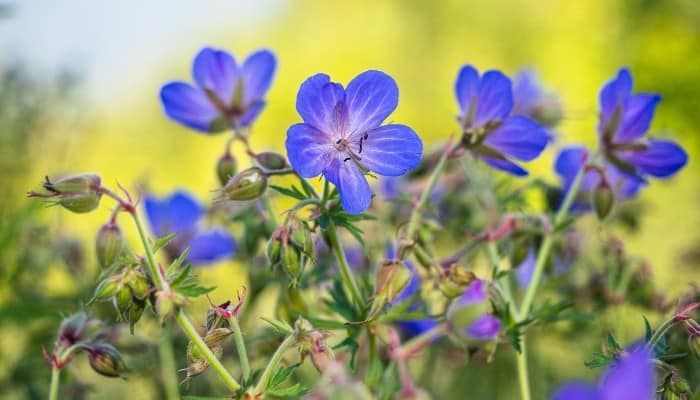
If you have a cottage garden, the cranesbill is an indispensible perennial to add color and luster to the place.
- Botanical Name: Geranium spp.
- Best for Grow Zones: 3-9 USDA
- Average Size: 6-24 inches tall
- Colors Available: Blue, pink, purple, white
- Light Requirements: Full sun
- Popular Varieties: Wargrave Pink, Gerwat Rozanne, Ann Folkard, Double Jewel, Southcombe Double
23. Clematis
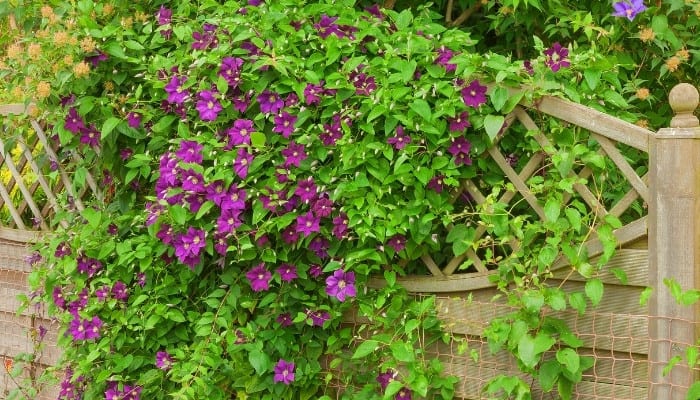
The fragrant flowers of this vine appear in the late summer and stay in bloom until the fall.
- Botanical Name: Clematis terniflora
- Best for Grow Zones: 5-9 USDA
- Average Size: 15-30 feet long
- Colors Available: Blue-purple
- Light Requirements: Full sun to partial shade
- Popular Varieties: Jackman’s Clematis, Clematis The President
24. Pincushions
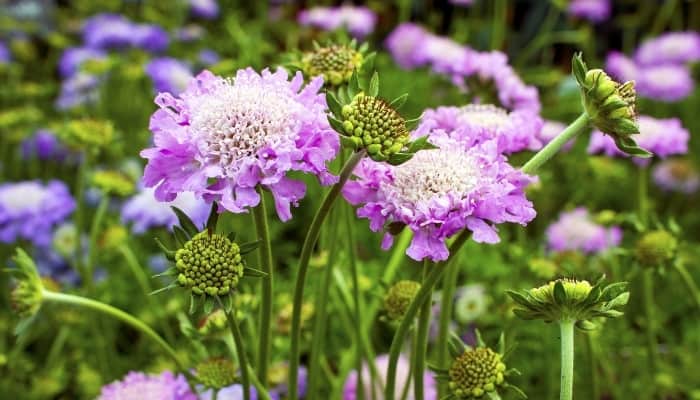
Start these plants in the early spring. They take up to 100 days to mature.
- Botanical Name: Scabiosa
- Best for Grow Zones: 3-7 USDA
- Average Size: 12-18 inches tall and wide
- Colors Available: White, pink, lavender, red, burgundy, cream
- Light Requirements: Full sun
- Popular Varieties: Black Knight, Butterfly Blue, Fama White, Pink Mist
25. Mums

The hardy mums bloom in the fall.
- Botanical Name: Chrysanthemum morifolium
- Best for Grow Zones: 5-9 USDA
- Average Size: 2-3 feet tall and 1-2 feet wide
- Colors Available: Burgundy, pink, gold, yellow, bronze, red, lavender, purple, cream, white
- Light Requirements: Full sun
- Popular Varieties: Anemone, Pom Pom, Spoon
Tips for Planting in Containers
- You can use anything that holds soil as a container.
- Make sure the container has drainage holes at the bottom.
- Group plants of different sizes and colors.
- Always choose a container one size larger than you think you need to avoid rootbound conditions.

![25 Perennials for Containers [With Pics & Planting Tips]](https://whyfarmit.com/wp-content/uploads/2022/01/Variety-of-container-plants.jpg)